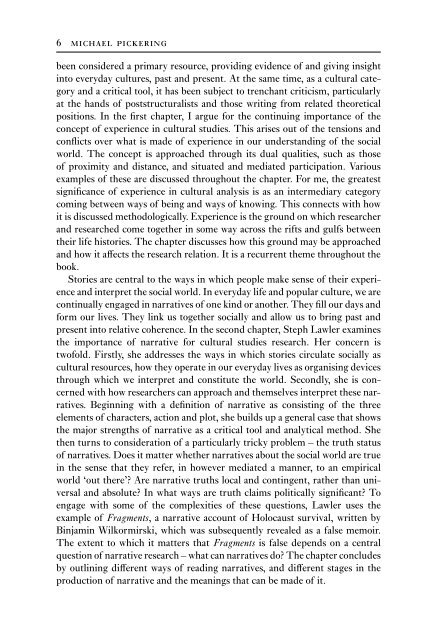Research Methods for Cultural Studies
Research Methods for Cultural Studies
Research Methods for Cultural Studies
Create successful ePaper yourself
Turn your PDF publications into a flip-book with our unique Google optimized e-Paper software.
6 michael pickering<br />
been considered a primary resource, providing evidence of and giving insight<br />
into everyday cultures, past and present. At the same time, as a cultural category<br />
and a critical tool, it has been subject to trenchant criticism, particularly<br />
at the hands of poststructuralists and those writing from related theoretical<br />
positions. In the first chapter, I argue <strong>for</strong> the continuing importance of the<br />
concept of experience in cultural studies. This arises out of the tensions and<br />
conflicts over what is made of experience in our understanding of the social<br />
world. The concept is approached through its dual qualities, such as those<br />
of proximity and distance, and situated and mediated participation. Various<br />
examples of these are discussed throughout the chapter. For me, the greatest<br />
significance of experience in cultural analysis is as an intermediary category<br />
coming between ways of being and ways of knowing. This connects with how<br />
it is discussed methodologically. Experience is the ground on which researcher<br />
and researched come together in some way across the rifts and gulfs between<br />
their life histories. The chapter discusses how this ground may be approached<br />
and how it affects the research relation. It is a recurrent theme throughout the<br />
book.<br />
Stories are central to the ways in which people make sense of their experience<br />
and interpret the social world. In everyday life and popular culture, we are<br />
continually engaged in narratives of one kind or another. They fill our days and<br />
<strong>for</strong>m our lives. They link us together socially and allow us to bring past and<br />
present into relative coherence. In the second chapter, Steph Lawler examines<br />
the importance of narrative <strong>for</strong> cultural studies research. Her concern is<br />
twofold. Firstly, she addresses the ways in which stories circulate socially as<br />
cultural resources, how they operate in our everyday lives as organising devices<br />
through which we interpret and constitute the world. Secondly, she is concerned<br />
with how researchers can approach and themselves interpret these narratives.<br />
Beginning with a definition of narrative as consisting of the three<br />
elements of characters, action and plot, she builds up a general case that shows<br />
the major strengths of narrative as a critical tool and analytical method. She<br />
then turns to consideration of a particularly tricky problem – the truth status<br />
of narratives. Does it matter whether narratives about the social world are true<br />
in the sense that they refer, in however mediated a manner, to an empirical<br />
world ‘out there’? Are narrative truths local and contingent, rather than universal<br />
and absolute? In what ways are truth claims politically significant? To<br />
engage with some of the complexities of these questions, Lawler uses the<br />
example of Fragments, a narrative account of Holocaust survival, written by<br />
Binjamin Wilkormirski, which was subsequently revealed as a false memoir.<br />
The extent to which it matters that Fragments is false depends on a central<br />
question of narrative research – what can narratives do? The chapter concludes<br />
by outlining different ways of reading narratives, and different stages in the<br />
production of narrative and the meanings that can be made of it.


